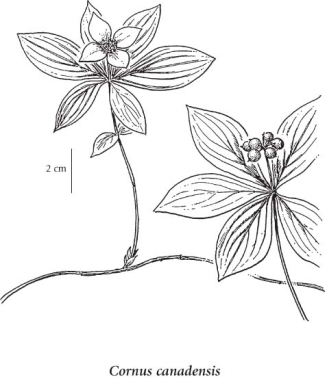bunchberry (bunchberry dogwood; Canadian bunchberry)
Cornaceae (Dogwood family)
Introduction to Vascular Plants
Photograph
© Gordon Neish (Photo ID #14886)
Species Information
General:
Low, trailing perennial herb from a rhizome with a somewhat woody base; stems erect, solitary, simple, 5-25 cm tall, minutely hairy, greenish to reddish, leafless or with bracts on the lower part.
Leaves:
Evergreen more or less, 4-7 in a terminal whorl, oblong egg-shaped to diamond-shaped, short-stalked, 2-8 cm long, green above, whitish beneath, lateral veins arising from the midvein in the lower third of the leaf.
Flowers:
Inflorescence of a solitary, stalked, umbrella-shaped cluster subtended by 4 white to pinkish or purplish-tinged, broadly to narrowly egg-shaped bracts; petals 1-1.5 mm long, greenish-white with a purplish tinge.
Fruits:
Fleshy drupes, 6-8 mm long, bright coral red when mature, usually several.
Notes:
Hybrids between C. canadensis and C. suecica have been treated as either a variety of C. canadensis (var. intermedia Farr.) or as a separate species (C. unalaschkensis Ledeb.). The latter taxon is a common tetraploid with features between its parents.
Illustration

If more than one illustration is available for a species (e.g., separate illustrations were provided for two subspecies) then links to the separate images will be provided below. Note that individual subspecies or varietal illustrations are not always available.
Illustration Source: The Illustrated Flora of British Columbia
USDA Species Characteristics
Flower Colour:
White
Blooming Period:
Late Spring
Fruit/Seed characteristics:
Colour: Red
Present from Summer to Fall
Source: The USDA
Ecology
The table below shows the species-specific information calculated from
original data (BEC database) provided by the BC Ministry of Forests and Range.
(Updated August, 2013)
| Site Information |
Value / Class |
||
|
Avg |
Min |
Max |
|
| Elevation
(metres) |
923 | 0 | 2500 |
| Slope
Gradient (%) |
17 | 0 | 350 |
|
Aspect (degrees) |
332 | 0 | 360 |
| Soil
Moisture Regime (SMR) [0 - very xeric; 4 - mesic; 8 - hydric] |
4 | 0 | 8 |
| Modal
Nutrient Regime
Class |
C | ||
| #
of field plots species was recorded in: |
17688 | ||
| Modal
BEC Zone Class |
SBS | ||
|
All BEC Zones (# of stations/zone) species was recorded in |
AT(1), BAFA(5), BWBS(1572), CDF(4), CMA(4), CWH(2643), ESSF(2164), ICH(3604), IDF(530), MH(277), MS(1501), PP(3), SBPS(374), SBS(3649), SWB(244) | ||
|
Source:
Klinkenberg 2013
|
|||
Habitat and Range
Moist to mesic forests and openings in all but the alpine zone; common throughout BC; amphiberingian, N to AK, YT and NT, E to NF and S to MN, PA, NM and CA; E. Asia.Status Information
Synonyms
Synonyms and Alternate Names:
Chamaepericlymenum canadense (L.) Asch. & Graebn.
Cornella canadensis (L.) Rydb.
Cornus canadensis var. dutillyi (Lepage) B. Boivin
Similar Species
There are three species of bunchberry in British Columbia: Cornus canadensis, Cornus suecica, and Cornus unalaschkensis. All three species are very similar in appearance, and are not easy to separate, often requiring microscopic work. However there are some distinguishing characteristics that are readily visible. Griffith and Ganders (1983) provides the following description of the three species:
"[Cornus canadensis] has four to six leaves at the top of its stem and greenish-white petals (not the showy white bracts, but the tiny petals inside the bracts).....[Cornus suecica] has three to six more or less equal pairs of leaves along it's short stem....the petals are purple or at least partially purple......[Cornus unalaschkensis] has flowers like those of [Cornus suecica], but has whorls of leaves like those of [Cornus canadensis]." |
Taxonomic Notes
An excellent native groundcover for part shade and loose humusy soils. Produces lovely white dogwood flowers and red berries. Fall foliage becomes nicely tinted with red and burgundy.
Coniferous woods, thickets and damp clearings in peaty soils. Note Author: Gary Lewis, Phoenix Perennials |